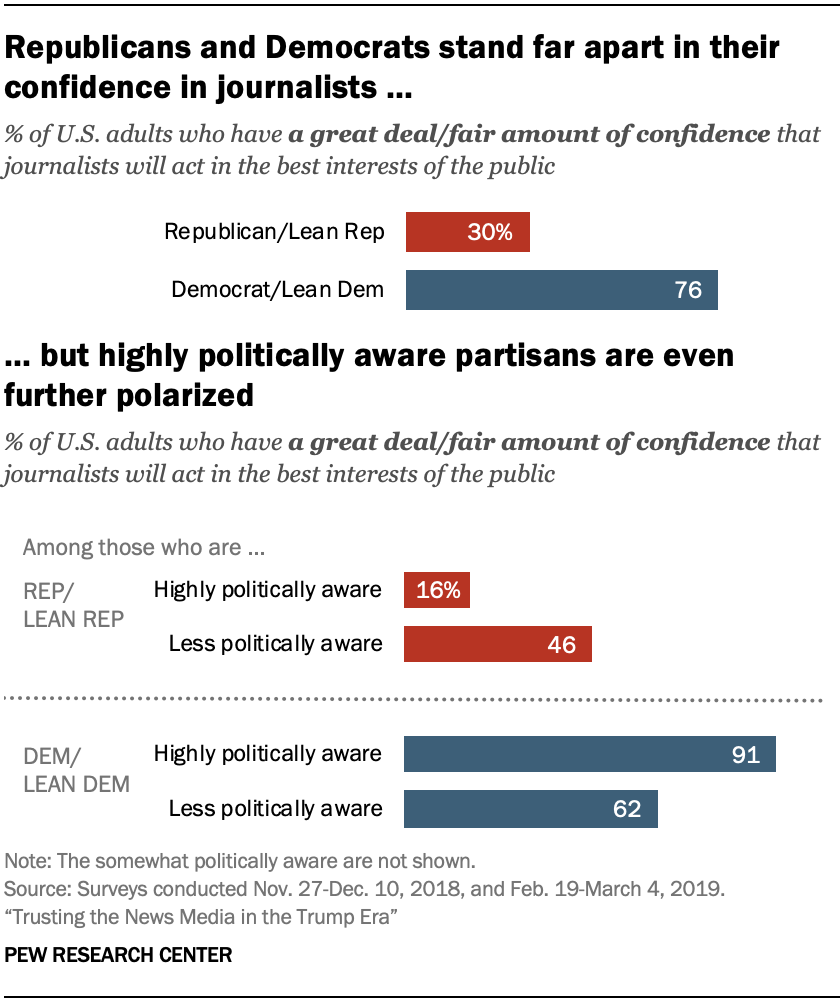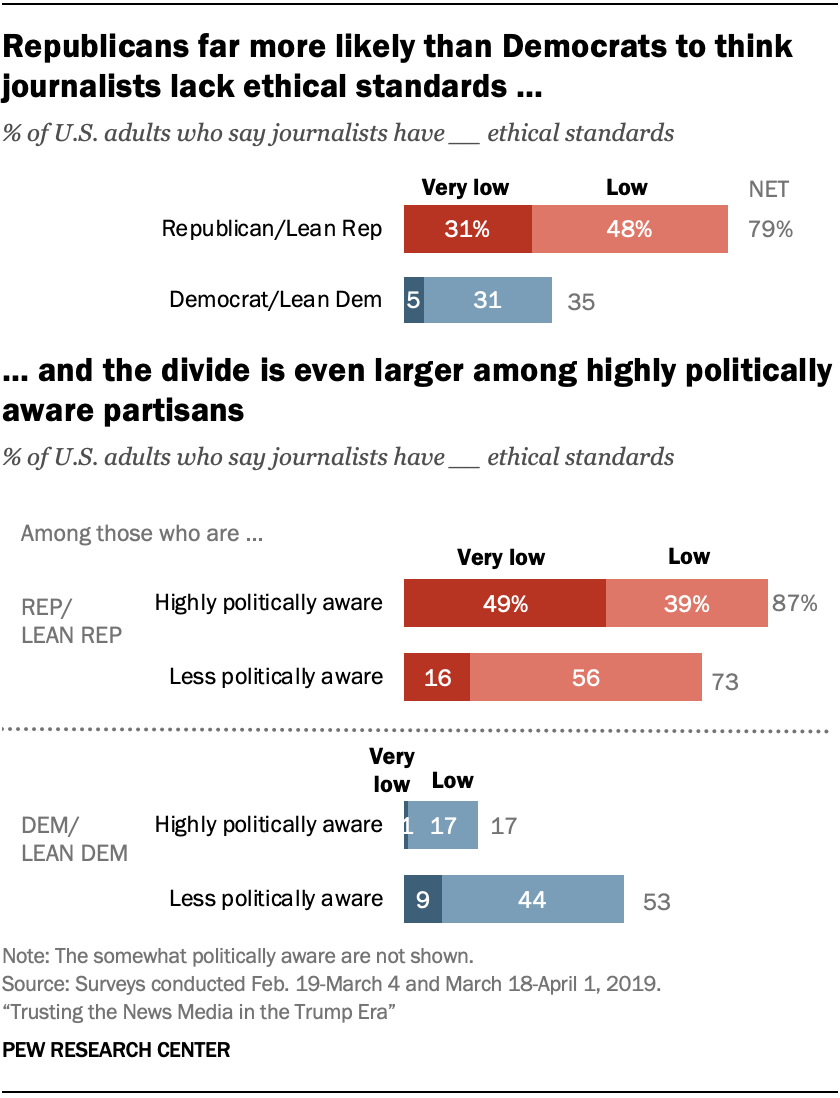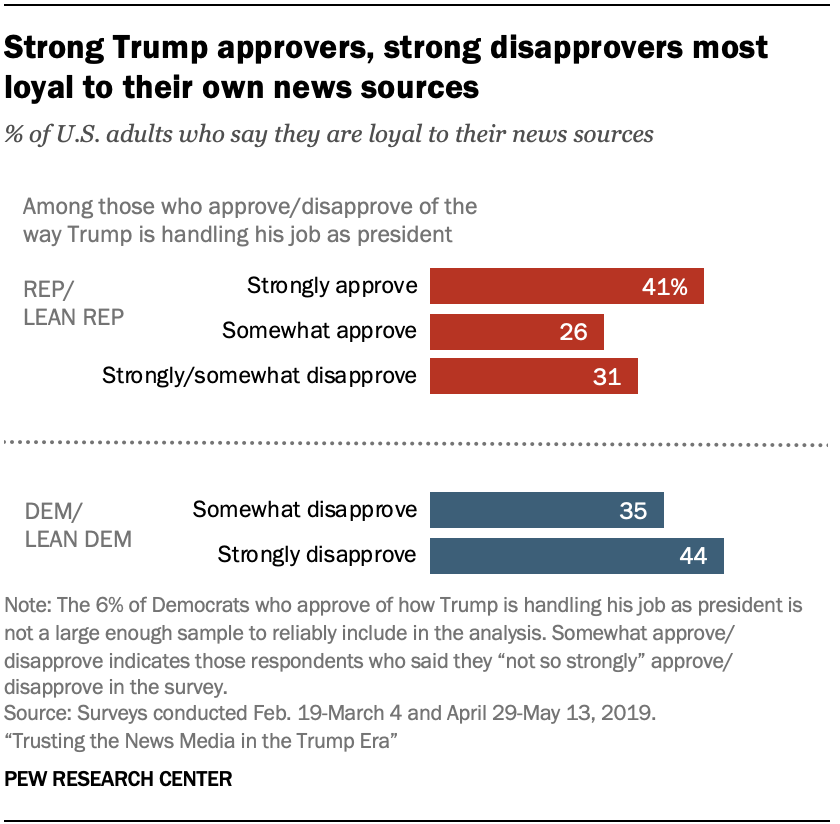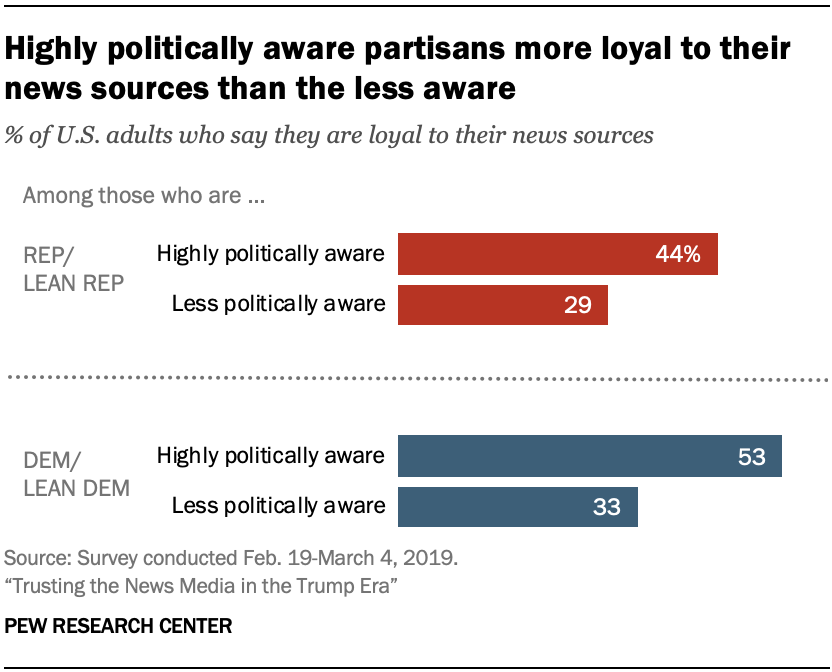The public’s level of engagement – both politically and with the news – adds another dimension to partisans’ evaluations of the news media. Divides within the parties once again emerge, and partisans who are highly engaged are the most polarized in a range of views of the news media.

In general, Republicans and Republican leaners who are highly engaged with politics or with the news tend to be more negative toward the news media than less engaged Republicans, and highly engaged Democrats and Democratic leaners are typically more supportive of the news media than their less engaged counterparts. Taken together, stark divides emerge between the highly engaged Republicans and Democrats – divides that are often more pronounced than among partisans overall.5 (For more information on the two measures of engagement – political awareness and news engagement – see the box below.)
For example, Americans’ level of confidence that journalists will act in the best interests of the public clearly shows how partisan divides are even starker among the highly engaged. In this case, the two parties begin with quite different levels of confidence – 30% of Republicans versus 76% of Democrats overall have a great deal or fair amount of confidence. But then looking within party, highly politically aware Republicans are 30 percentage points less likely than less aware Republicans to say this (16% vs. 46%). And highly aware Democrats are 29 points more likely than their less aware counterparts to express this level of confidence (91% vs. 62%).
Across parties, though, the divide between highly engaged Republicans and Democrats is far larger. The 46 percentage point gap between Republicans and Democrats overall increases to 75 points. A similar pattern emerges when looking at news engagement: There is a 66 percentage point difference between Republicans and Democrats who are highly engaged with news (23% vs. 89%, respectively).

The highly and less engaged in each party are similarly divided in their views of journalists’ ethics. Highly politically aware Republicans are 14 percentage points more likely than those who are less engaged to think that journalists have low or very low ethics (87% vs. 73%) – a gap that is 33 points when considering only those who say very low (49% vs. 16%). And among Democrats, there is a 36-point difference between the highly and less politically aware who say journalists have low or very low ethics (17% vs. 53%).
As with confidence, there is again a substantial divide between highly engaged partisans. The 44-point gap between Republicans and Democrats overall in their view of whether journalists have low or very low ethical standards grows to 70 points between the highly politically aware Republicans and Democrats. And again, a similar pattern emerges among Republicans and Democrats who are highly engaged with news.
On the other measures of trust analyzed in this study, there are also large divides between highly engaged Republicans and Democrats on their trust in the information from national news organizations, views of the media’s watchdog role, and perceived fairness in coverage.6 These stark divides between highly engaged Republicans and Democrats are in line with previous studies that show large divides in political attitudes between the most engaged partisans.
In this study, we examined two different measures of engagement – political awareness and news engagement. Below is a description of how each of the two measures was constructed.
Political awareness is based on answers to three political knowledge questions and one question about how closely respondents say they follow what’s going on in government and public affairs. The “highly politically aware” are those who correctly answered all three knowledge items and say they follow politics most of the time – 31% of respondents. The “less politically aware” are the 41% who did not answer all three correctly (i.e., got at least one wrong) and say they follow politics less often. The remaining 27% fall in between and are termed the “somewhat politically aware.” Individuals in this group either follow politics most of the time or answered all three correctly, but not both.
News engagement is based on answers to two questions – how closely respondents follow news generally and whether they tend to seek out their news or happen up on it. The “highly engaged with news” are those who follow the news all or most of the time and tend to seek out their news — 42% of respondents. The “less engaged with news” follow the news less often and tend to happen upon their news – 28% of respondents. The remaining 29% of respondents are “somewhat engaged with news” – they either follow news all or most of the time, or tend to seek out their news, but not both.
The knowledge questions for the political awareness measure and the seeking question for the news engagement measure were asked on a survey conducted Feb. 19-March 4, 2019. The questions about following government and public affairs and following news were asked Aug. 20-Oct. 28, 2018. Engagement with politics and the news is not substantially connected to political party identification. For instance, highly politically aware adults make up about equal portions of both major parties – 33% of Republicans and Republican leaners and 32% of Democrats and Democratic leaners.
Across the measures in the analysis presented here, the middle groups mostly fall somewhere in between the highly engaged and the less engaged, though they occasionally fall closer to one group or the other. The findings in this section show the results comparing the “highly” and “less” engaged for each. For a look at the findings that include the “somewhat” engaged for both measures as well as a look the overall relationship between the two measures of engagement and trust, see the Appendix.
Partisans have similar levels of loyalty to their sources of news
While there are profound political divides in Americans’ views of the news media and journalists generally, partisanship is less connected to the public’s sense of loyalty to their own individually preferred sources of information – that is, those sources they tend to rely on most. Instead of stark divides, the most fervent partisans – Trump’s strongest approvers and detractors as well as those who are highly engaged with politics or with the news – are much more on par in their sense of loyalty and tend to be more loyal than their less fervent counterparts.

Republicans and Republican leaners who strongly approve of how Trump is handling his job as president feel more loyal to their news sources than those who somewhat approve or disapprove (41%, vs. 26% and 31% respectively). Likewise, strongly disapproving Democrats and Democratic leaners also feel more loyal than somewhat disapproving Democrats (44% vs. 35%). Taken together, the most approving Republicans and the least approving Democrats are about on par in their loyalty to their own news sources.

The highly engaged in each party – whether with politics or with the news – feel more loyal to their news sources than their less engaged counterparts. For instance, about half of the highly politically aware (49%), say they are loyal to their sources of news, 18 percentage points higher than the less aware (31%) – a pattern that is evident within both parties. Highly politically aware Republicans are 15 points more likely than less aware Republicans to feel loyal to their news sources, and highly aware Democrats are 20 points more likely than less aware Democrats. Again, the same pattern exists with the other measure of engagement – engagement with the news.